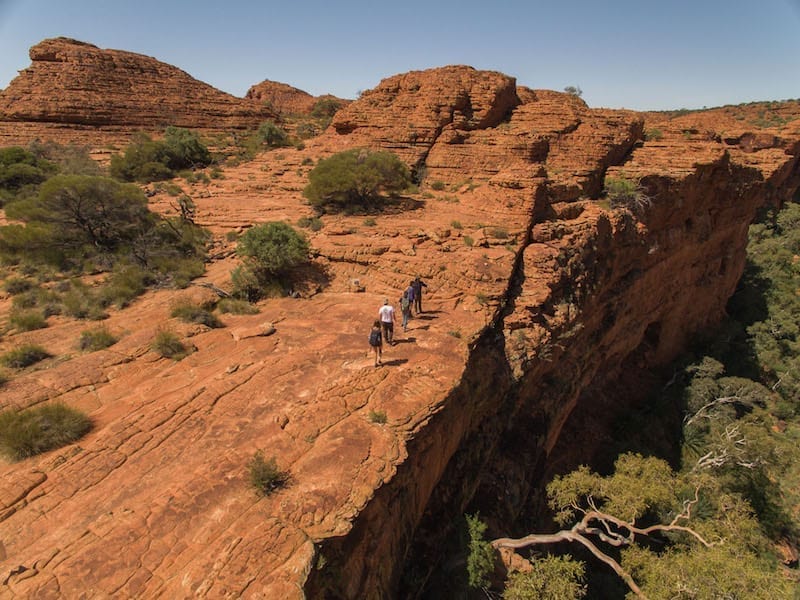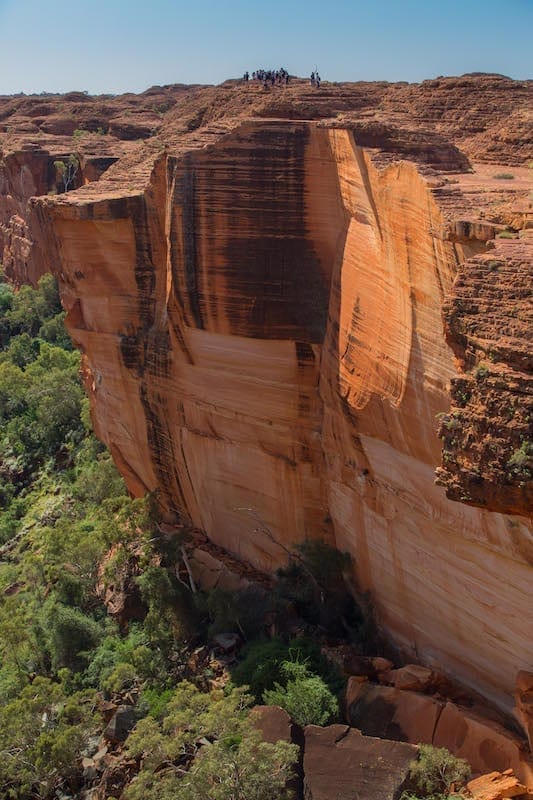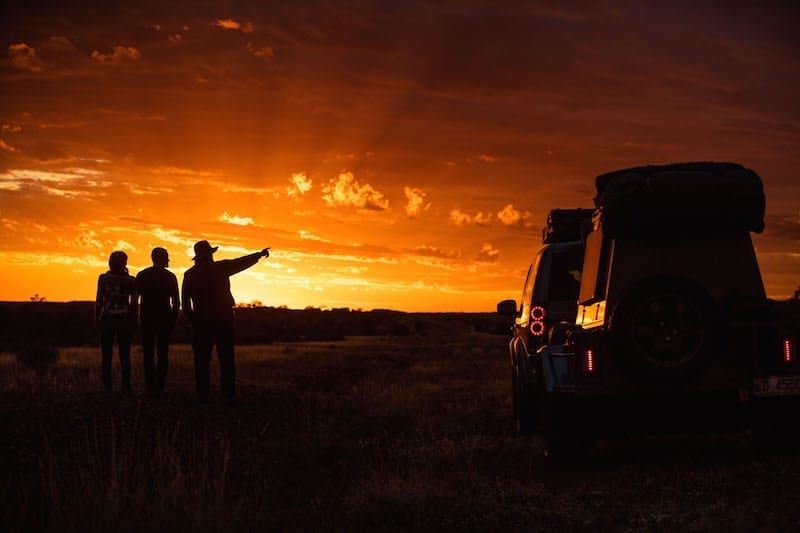For more than two decades, Off The Map Productions has been doing just that – criss crossing the highways and byways of Australia, island hopping the Pacific and exploring the back of beyond.
Along the way the’ve filmed Orangutan’s in the swamp forests of Northern Sumatra, pearl diving and burial caves in the Cook Islands, skiing live volcano’s in Vanuatu, Great Whites in South Australia and the tops of ancient Kauri tree’s in New Zealand.
Here, with the first video in our series Australia Unearthed, we are excited to bring you the first ever professional drone film footage of the spectacular Kings Canyon in the Northern Territory thanks to Wayoutback, Northern Territory Parks, and the local Anangu.
Drones can be noisy, obtrusive and prone to sudden destruction or disappearance – but visually a drone offers a new dimension. The ability to reveal the immensity of the place from above, or to cover ground fast or and drop down to float slow and low along canyon walls – is a filmmakers dream.

For those travellers, all of the local legends we come across, and their special places, Australia Unearthed is an exploration of the unusual, the unexpected and sometimes subtle discoveries to be found on this, the world’s largest island continent.
Australia’s Northern Territory holds many of Australia’s most impressive wild places
Once encountered the landscapes of Kakadu, Litchfield and Uluru Kata Tjuta National Parks are unforgettable. Many travellers leave shaking their heads, with visions of impossibly dramatic vistas, wildlife and stories from ancient cultures, forever etched in their minds.
The heart of the ‘Red Centre’ is the 600 million year old monolith the Aboriginals call Uluru. Uluru might possibly be the most imposing and yet dramatically beautiful natural landmark to be found anywhere in the world. Once it sat on the sea floor, but today rises 348 metres above a flat desert plain – significantly higher than any of Australia’s tallest buildings. What we can see of Uluru is only a small part of a single huge rock. Like a landlocked iceberg it also extends down beneath the surface – how far no one really knows but experts estimate there is more than 2.5 square kilometres underground.
About 250,000 tourists visit ‘The Rock’ each year. More impressive is the fact that humans, Aboriginals, probably gazed at it with the same kind of wonder at least 10,000 years ago.
It’s no surprise that on this ‘Australia Unearthed’ journey the film-makers jumped at the chance to join their friends at Wayoutback Tours to film Uluru and Kata Tjuta National Park – and because of the nature of their tours, to revisit a few of the lesser known locations we think people should know more about.
Unlike the name ‘Uluru’ if you mention Watarrka most visitors to Australia’s Red Centre won’t have a clue what you are talking about – despite the fact that it’s a National Park covering a massive 725 square kilometres area (bigger than Singapore) – and that it’s just down the Road from the townships of Yulara and Alice Springs.
Ok it’s just 300km’s down the road, Northeast from Yulara and a bit further Southwest from Alice, into what some might call desert – but there is a resort, importantly a pub, Camels?! and plenty of great camping spots.
With only 60,000 visitors a year even finding their way to Watarrka’s centrepiece, Kings Canyon (most on day tours), we think it’s a place worth putting on the travel plan and a place worth going out of your way for.
Ecologically the Park is interesting because it’s location straddles demarcation lines bordering several different ecosystems. In some places the flora and fauna of the Western desert overlaps with the more varied kind from the MacDonnell ranges, in others the harsh vegetation of the Simpson desert creeps in.
Geologically this convergence is means that flat desert dune country meets dramatic canyons and bush clad gorges that dig and weave themselves into mountain ranges in a battle of the elements that in one way or another has been going on for hundreds of millions of years.
Fossils litter the place, there are rare reptiles, ancient plant species from different geological times, and somewhere in amongst all this, toward the end, modern animals and humans turned up.
At the centre Watarrka, or Kings Canyon as it is widely known is a giant rift in the earth eroded by inland lakes over 440 million years.

The Canyon, and Kings Creek were both named by Explorer Ernest Giles. Apparently Ernie named them both not for his King and country – but for his mate, Mr Fielder King. Nice.
‘Watarrka’ is the Aboriginal name for the native ‘Umbrella plant’ (Acacia Ligulata).
Aboriginals have continuously occupied Watarrka for at least 20,000 years so it’s also interesting to think that the ‘Umbrella plants’ have been around in the Australian landscape for this duration – they are still quite common in many city suburbs and even in offices (where they are used mostly to absorb hot air…)
A dense stand of Watarrka grows at the entrance to the canyon and I’m sure back then without umbrella’s and selfie sticks they were bloody useful in the 40 degree heat.
The crew first filmed Kings Canyon in 1996 and apart from the terror of something walking across their swag big enough to wake them up in the middle of the night.
On that trip they lugged an old ‘tubie’ Betacam camera, a massive tripod and a bag full of batteries up ‘heart attack hill’ (500 hundred steps, felt like thousands…) up, around, down, through and back again. It took hours and they barely made it out before dark sunburnt and exhausted.
Since then they’ve photographed up the easier valley floor walk, but not the much more challenging Canyon rim walk.
Sensible people get up and into it early – like the Wayoutback guide who was obviously a politician or lawyer in a past life and convinced his passengers to stagger out of their swags at 4 am, pack up and climb to the canyon rim for sunrise.
This is something we should all do given the chance. During the early morning and late evening the harsh blue light softens to exaggerate the rich red and yellow tones of the sandstone cliffs, and amongst the deep shadows life seems to awaken in a whisper of buzzing, the echo of shrill bird calls, or the short, sharp bark of a Dingo. It’s at these times that you can understand what a refuge this place is and must have been for humans and animals alike over thousands of years.
As a film location it’s always a magnetic, almost overwhelming landscape – there are just so many angles to take in, so much detail.
Drones are great for shooting into, and around the moment of sunrise but options get limited as the shadows harden with light gaining strength. Like most camera’s even high end drones struggle with extreme contrast – so without the luxury of time to do both, the option to shoot with a high midday sun and afternoon light made some sense.

Other challenges for flying drones in remote areas include losing signal – they need signal from several satellites to keep under control, running out of battery – each only last about 15 minutes, and with a top speed of 70 km per hour and a 3km range, losing perspective of where you are.
Despite crash avoidance software positioning close to walls can also be extremely challenging without crashing into them (the avoidance software many drones only works facing forward)
Luckily the pilot Alex had got his coffee and muesli bar mix just right and pulled off some amazing flying manoeuvres while below we focused on the travellers.
It was interesting that over the 8hrs with the heat, and all of the backtracking, waiting and several kilometres of walking, there wasn’t any muttering or complaint.
More often when Adam the Wayoutback guide wasn’t rattling off facts and history, there was a kind of spellbound silence, an air of reflection and a reverence over the small group.
It’s difficult to understand the concept of ‘Dreaming’ or Dreamtime’ – even if these words don’t in themselves convey the correct meaning of what the Anangu regard as Tjukurpa or the ‘Law’.
But when you visit Watarrka you can sense that, amongst an immense passing of time, if it was your place, the land, the hills and creeks, each animal, each rock and tree could have a precise meaning and a significance bridging both the imagination and waking life.
The crew said they like to think that respectfully they all took just a small piece of Watarrka home that day and that these unique images in some way add to the significance of this incredible site – Watarrka, Kings Canyon Unearthed.
Film and Photography by Off The Map Productions, Post production by Filmotion Productions and Studio 1.
Established in 1999, Wayoutback Australian Safaris has forged an enviable reputation for running authentic small group experiences, incorporating indigenous culture for adventure travellers. From Uluru, the red heart of Australia, to the Tropical waterfalls and wetlands of Kakadu National Park, Wayoutback Australian Safaris deliver quality experiences throughout the Northern Territory.)









